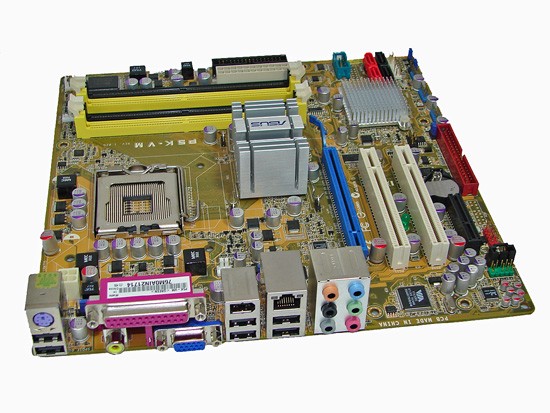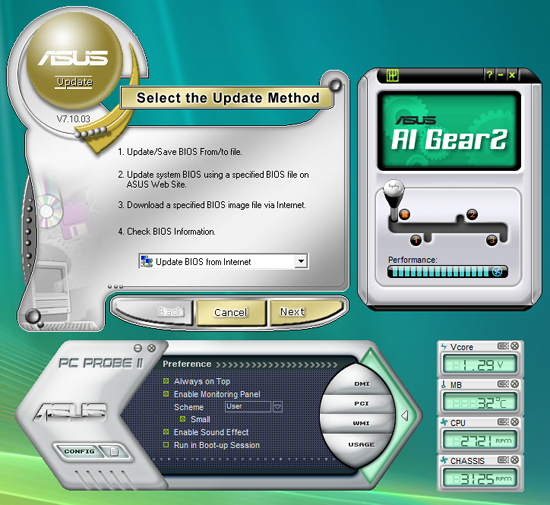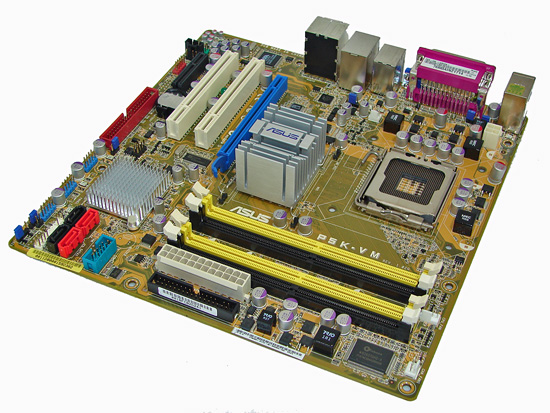µATX Part 2: Intel G33 Performance Review
by Gary Key on September 27, 2007 3:00 AM EST- Posted in
- Motherboards
ASUS P5K-VM: Board Layout and Features

The appearance of the P5K-VM is pretty dull in comparison to other ASUS products, but its in line with their previous uATX boards. We can't say outward appearances are all that important for this market, so we'll leave it at that. Like most of their boards, ASUS now uses Conductive Polymer Aluminum Solid Capacitors on the P5K-VM. We're not sure if there's really any need for using such capacitors, given the target audience, but the board did prove to be quite stable and is one of the better uATX overclockers presently available.
The capacitor design does have the advantage of making the board very clean, and there's plenty of room around the CPU socket for a variety of cooling solutions. Whether that's even necessary for uATX boards is a question we'll leave to the philosophers. (Anyone out there planning on using a uATX board with a Tuniq 120 or Thermalright Ultra-120?)
The rear panel is somewhat interesting in that it skips the PS/2 mouse port but includes a PS/2 keyboard connection. The panel also includes a parallel port, for those still running older printers or peripherals. Six USB ports, a LAN port, a coaxial S/PDIF out port, Firewire, and six audio jack (supporting 2, 4, 6, and 8-channel audio) are available.
One of the more questionable layout decisions on the part of the ASUS is their location of the IDE port. At the very bottom edge of the board, it will be very difficult to reach this location, especially if it's used with an optical drive. Luckily, SATA optical drives are becoming increasingly common, and we would recommend users purchase an appropriate SATA optical drive if possible. A floppy connector is also present, in case anyone actually needs one.
The board comes with (1) physical PCI-E x16 connector, (1) PCI-E x4 connector, and (2) PCI 2.2 slots. The first PCI slot will be blocked by a dual slot graphics card. Clearance between the DIMM socket clips and the x16 slot is also limited, requiring the removal of most longer GPUs in order to add or remove memory.
The chipsets are both passively cooled, with a large heatsink on the Northbridge. Three fan headers are available (one 4-pin and two 3-pin), which is pretty good for a uATX setup. Fan speed and monitoring control is present in the BIOS and can also be accessed by ASUS' Windows utilities.

ASUS provides their usual selection of software utilities for Windows although for this board, some of the more advanced features are not available. ASUS update can be used to update the BIOS as well as other ASUS utilities. AI Gear has profiles that allow the system to dynamically controlling the FSB and CPU voltages for power saving or performance conditions, and PC Probe allows monitoring of certain voltages and temperatures. While we appreciate the utilities from all of the manufacturers and actually use some of them, sometimes they come across to us as bloatware that 90% of people won't use. Ummm... moving on....

The appearance of the P5K-VM is pretty dull in comparison to other ASUS products, but its in line with their previous uATX boards. We can't say outward appearances are all that important for this market, so we'll leave it at that. Like most of their boards, ASUS now uses Conductive Polymer Aluminum Solid Capacitors on the P5K-VM. We're not sure if there's really any need for using such capacitors, given the target audience, but the board did prove to be quite stable and is one of the better uATX overclockers presently available.
The capacitor design does have the advantage of making the board very clean, and there's plenty of room around the CPU socket for a variety of cooling solutions. Whether that's even necessary for uATX boards is a question we'll leave to the philosophers. (Anyone out there planning on using a uATX board with a Tuniq 120 or Thermalright Ultra-120?)
The rear panel is somewhat interesting in that it skips the PS/2 mouse port but includes a PS/2 keyboard connection. The panel also includes a parallel port, for those still running older printers or peripherals. Six USB ports, a LAN port, a coaxial S/PDIF out port, Firewire, and six audio jack (supporting 2, 4, 6, and 8-channel audio) are available.
One of the more questionable layout decisions on the part of the ASUS is their location of the IDE port. At the very bottom edge of the board, it will be very difficult to reach this location, especially if it's used with an optical drive. Luckily, SATA optical drives are becoming increasingly common, and we would recommend users purchase an appropriate SATA optical drive if possible. A floppy connector is also present, in case anyone actually needs one.
 |
| Click to enlarge |
The board comes with (1) physical PCI-E x16 connector, (1) PCI-E x4 connector, and (2) PCI 2.2 slots. The first PCI slot will be blocked by a dual slot graphics card. Clearance between the DIMM socket clips and the x16 slot is also limited, requiring the removal of most longer GPUs in order to add or remove memory.
The chipsets are both passively cooled, with a large heatsink on the Northbridge. Three fan headers are available (one 4-pin and two 3-pin), which is pretty good for a uATX setup. Fan speed and monitoring control is present in the BIOS and can also be accessed by ASUS' Windows utilities.

ASUS provides their usual selection of software utilities for Windows although for this board, some of the more advanced features are not available. ASUS update can be used to update the BIOS as well as other ASUS utilities. AI Gear has profiles that allow the system to dynamically controlling the FSB and CPU voltages for power saving or performance conditions, and PC Probe allows monitoring of certain voltages and temperatures. While we appreciate the utilities from all of the manufacturers and actually use some of them, sometimes they come across to us as bloatware that 90% of people won't use. Ummm... moving on....










26 Comments
View All Comments
strikeback03 - Friday, September 28, 2007 - link
When building a couple computers for work using the MSI P35 Platinum board, it appears they don't support eSATA hot-swapping, at least not in XP. I know my Foxconn G965 board at home can do it. Is this behavior still present in the MSI board here? Is it a P35 limitation, or BIOS, or what?hans007 - Friday, September 28, 2007 - link
I dont get it...an svdo card (add2-n) with dvi output costs what $6 on ebay. why dont you guys just buy one, so you can test these with digital.
also the video driver in vista 32bit is not as mature still as the recently released gma 3000 compatible XP driver.
most people actually have XP so could another round of benchmarks in XP be run? I probably wont even get vista for at leas tanother year, since well its pointless and has no reason for being bought at this point.
lopri - Saturday, September 29, 2007 - link
Well.. it seems like you're using Windows XP and a monitor via VGA. Then why bother with these new IGP-based mATX boards? 915G/945G (or GeForce 6100) series would be a better choice for you. They are a lot cheaper (~$50 probably) and XP support is as mature as can be.In the center of this new wave of IGPs is the advent of HD contents. Vista is kinda necessary-evil in a sense but in general it handles HD and multimedia contents a lot better than XP and has a more intuitive/prettier UI for a living room environment. CRT has long been dead in living rooms, and if you prefer CRT over LCD for some reason (professional gaming maybe?) IGP wouldn't be an option to begin with.
I'd say DVI is the minimum requirement, HDMI w/HDCP being a preferred solution in these days and nights.
veritronx - Thursday, September 27, 2007 - link
One thing that may have been overlooked.. The MSI board is the only one suitable for people looking to use a dual-slot graphics card as well as, say, a creative sound card, with some space between them. For that reason the only board reviewed that I would look at buying would be the MSI.Ajax9000 - Thursday, September 27, 2007 - link
From page 1:Read the following Nvidia pages and the news is somewhat disappointing re HD video.
Summary PDF -- http://www.nvidia.com/object/IO_35712.html">http://www.nvidia.com/object/IO_35712.html
AMD (MCP78) features -- http://www.nvidia.com/object/mobo_gpu_features_ben...">http://www.nvidia.com/object/mobo_gpu_features_ben...
AMD (MCP78) specs -- http://www.nvidia.com/object/mobo_gpu_tech_specs.h...">http://www.nvidia.com/object/mobo_gpu_tech_specs.h...
Intel (MCP73) features -- http://www.nvidia.com/object/mcp_features_benefits...">http://www.nvidia.com/object/mcp_features_benefits...
Intel (MCP73) specs -- http://www.nvidia.com/object/mcp_intel_techspecs.h...">http://www.nvidia.com/object/mcp_intel_techspecs.h...
PureVideo is only listed for the MCP78 (7050PV+630a) combination. All the other AMD chipsets and none of the Intel chipsets have PureVideo HD.
If, in the future, they release an MCP73 using (say) 7050PV+630i then memory will be limited to DDR667.
There is no details thus far, but what would be good is if the new chipset fixes the HD Audio problem that all current HDMI video cards seem to suffer from (i.e. the problem whereby the chipset supports HD Audio, but the video cards can only accept SPDIF-grade audio for HDMI pass-through).
BansheeX - Thursday, September 27, 2007 - link
Everyone who is letting these boards have it for not including HDMI/DVI is completely right. It makes no sense. Sure, I could buy a cheap DVI graphics card and stick in there, but if I have to do that, why would I buy a board with onboard graphics in the first place?Sadly missing from this review is the board that DOES include onboard DVI, Intel's own DG33TL. Even sadder is that it takes Intel to make the feature-full board while the OEM companies go for the minimum.
Emma - Thursday, September 27, 2007 - link
I agree with the others, as most computers I build have IGP's, being able to directly compare each of the available IGP's on the market would be about the best thing from a review for a long time.The 6100/6150SE should also be included as this is still widely sold.
Also of interest would be a summary of what other nVidia and AMD IGP's are on the horizon.
Thanks!
Owls - Thursday, September 27, 2007 - link
"We generally feel that users like to install games into the same colored slots for dual channel operation, but MSI chooses to color channel A orange and channel B green."I wasn't aware you could install games into DIMM slots.
JarredWalton - Thursday, September 27, 2007 - link
Sorry 'bout that - I was helping Gary out a bit and managed to mangle the text. Blame the speech recognition. That or I'm just slurring my words a bit. :)8steve8 - Thursday, September 27, 2007 - link
great article tackling most the issues that we care about!question #1: why bother reviewing boards without DVI or HDMI?
whether we are building pc's for friends/offices etc, or an office/server box for ourselves, or we want it to find a home in its post-gaming life when we ditch it for something better... DVI will be key. inexcusable that they pinch pennies there and frankly not worth your time considering these boards. gigabyte has a g33 board with dvi/hdmi, as does intel...
http://www.newegg.com/Product/Product.aspx?Item=N8...">http://www.newegg.com/Product/Product.aspx?Item=N8...
http://www.newegg.com/Product/Product.aspx?Item=N8...">http://www.newegg.com/Product/Product.aspx?Item=N8...
question #2: this would have been muuuch more useful like 5 months ago when G33 was new. now it's about to be eclipsed by the 7150 and g35.
overall i cant wait to see a similar roundup with modern chipsets like g35/nvidia 7150/ g690 and 7050pv for amd...
would be interesting to see a cost/perf of integrated platforms including cpu costs...
mobo + cpu costs... it seems amd has some good cheap 690g boards out there, with dvi/hdmi for around $75. (almost $50 cheaper than a g33 board with dvi)...